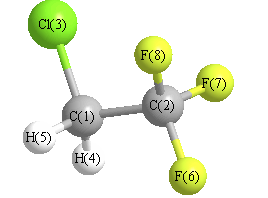Vibrational Frequencies calculated at HF/daug-cc-pVTZ
| Mode Number |
Symmetry |
Frequency
(cm-1) |
Scaled Frequency
(cm-1) |
IR Intensities
(km mol-1) |
Raman Act
(Å4/u) |
Dep P |
Dep U |
|---|
| 1 |
A' |
3259 |
2948 |
11.55 |
|
|
|
| 2 |
A' |
1603 |
1450 |
25.81 |
|
|
|
| 3 |
A' |
1495 |
1352 |
71.31 |
|
|
|
| 4 |
A' |
1405 |
1271 |
153.51 |
|
|
|
| 5 |
A' |
1302 |
1178 |
291.89 |
|
|
|
| 6 |
A' |
934 |
845 |
19.75 |
|
|
|
| 7 |
A' |
859 |
777 |
40.78 |
|
|
|
| 8 |
A' |
699 |
632 |
34.25 |
|
|
|
| 9 |
A' |
587 |
531 |
7.56 |
|
|
|
| 10 |
A' |
386 |
349 |
0.28 |
|
|
|
| 11 |
A' |
199 |
180 |
1.57 |
|
|
|
| 12 |
A" |
3324 |
3007 |
0.35 |
|
|
|
| 13 |
A" |
1440 |
1303 |
202.03 |
|
|
|
| 14 |
A" |
1236 |
1118 |
87.05 |
|
|
|
| 15 |
A" |
1002 |
906 |
9.18 |
|
|
|
| 16 |
A" |
588 |
532 |
2.46 |
|
|
|
| 17 |
A" |
381 |
345 |
1.36 |
|
|
|
| 18 |
A" |
108 |
98 |
3.53 |
|
|
|
Unscaled Zero Point Vibrational Energy (zpe) 10402.6 cm
-1
Scaled (by 0.9046) Zero Point Vibrational Energy (zpe) 9410.2 cm
-1
See section
III.C.1 List or set vibrational scaling factors
to change the scale factors used here.
See section
III.C.2
Calculate a vibrational scaling factor for a given set of molecules
to determine the least squares best scaling factor.
Charges, Dipole, Quadrupole and Polarizability
Charges from optimized geometry at HF/daug-cc-pVTZ
Charges (e)
| Number |
Element |
Mulliken |
CHELPG |
AIM |
ESP |
| 1 |
C |
-0.963 |
|
|
|
| 2 |
C |
2.664 |
|
|
|
| 3 |
Cl |
-0.588 |
|
|
|
| 4 |
H |
0.550 |
|
|
|
| 5 |
H |
0.550 |
|
|
|
| 6 |
F |
-0.715 |
|
|
|
| 7 |
F |
-0.748 |
|
|
|
| 8 |
F |
-0.748 |
|
|
|
Electric dipole moments
Electric dipole components in Debye
(What's a Debye? See section
VII.A.3)
| |
x |
y |
z |
Total |
| |
-1.370 |
1.514 |
0.000 |
2.042 |
| CHELPG |
|
|
|
|
| AIM |
|
|
|
|
| ESP |
|
|
|
|
Electric Quadrupole moment
Quadrupole components in D Å
| Primitive |
|---|
| | x | y | z |
|---|
| x |
-41.176 |
-2.764 |
0.000 |
| y |
-2.764 |
-40.021 |
0.000 |
| z |
0.000 |
0.000 |
-39.815 |
|
| Traceless |
|---|
| | x | y | z |
|---|
| x |
-1.258 |
-2.764 |
0.000 |
| y |
-2.764 |
0.475 |
0.000 |
| z |
0.000 |
0.000 |
0.783 |
|
| Polar |
|---|
| 3z2-r2 | 1.566 |
|---|
| x2-y2 | -1.155 |
|---|
| xy | -2.764 |
|---|
| xz | 0.000 |
|---|
| yz | 0.000 |
|---|
|
Polarizabilities
Components of the polarizability tensor.
Units are
Å
3 (Angstrom cubed)
Change units.
| |
x |
y |
z |
| x |
5.905 |
0.747 |
0.000 |
| y |
0.747 |
6.361 |
0.000 |
| z |
0.000 |
0.000 |
5.189 |
<r2> (average value of r
2) Å
2
| <r2> |
185.381 |
| (<r2>)1/2 |
13.615 |
